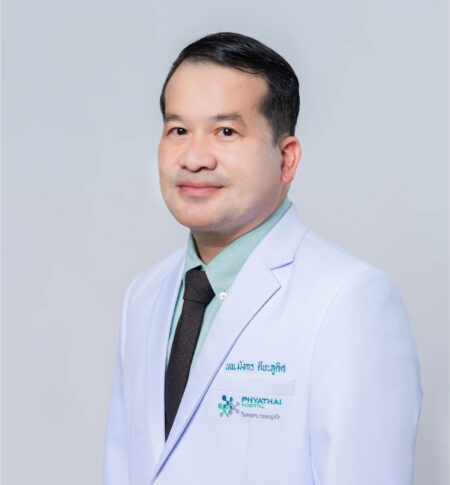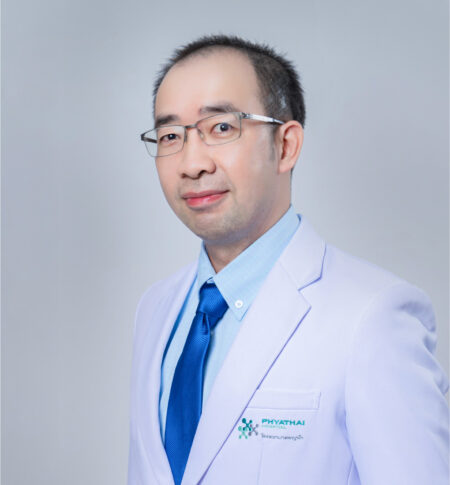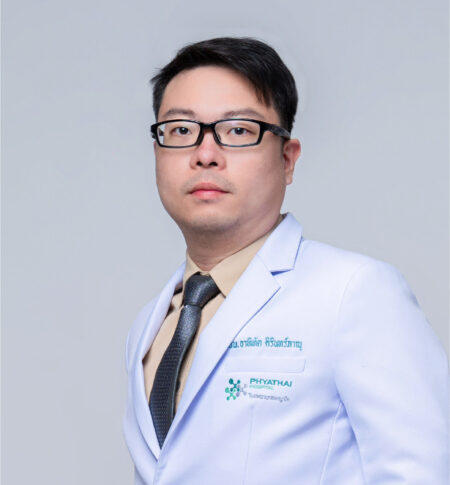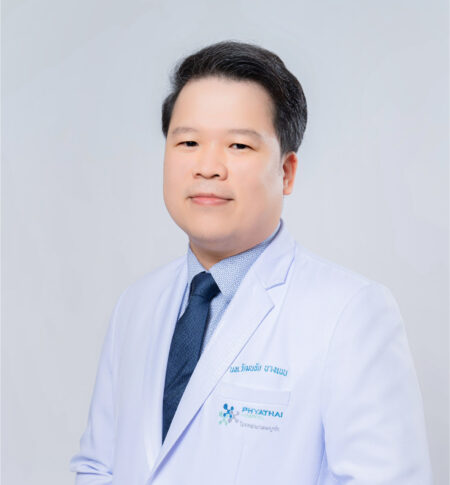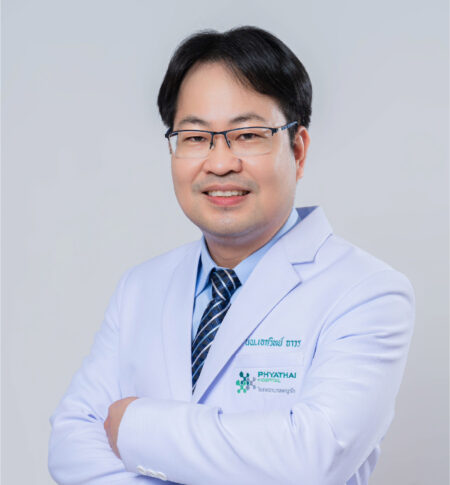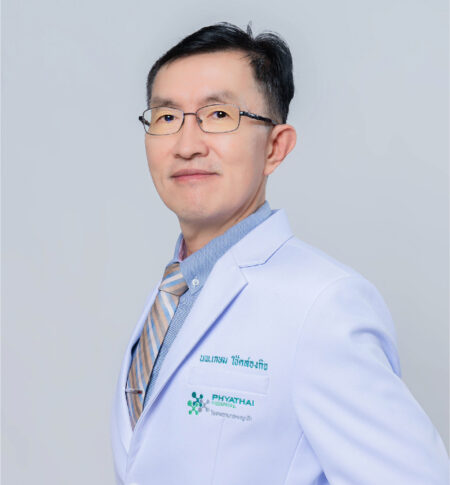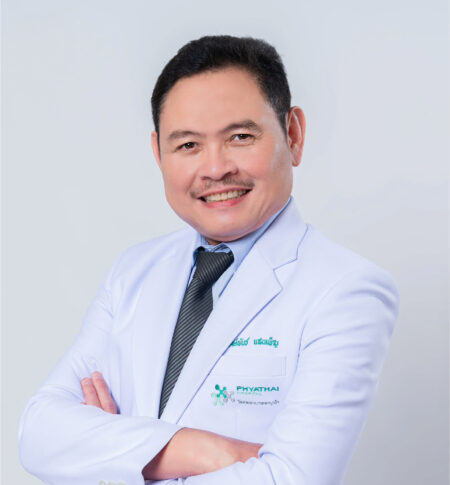
Dr. Mungkorn Teeyaphudit
Although advanced technology and tools in orthopedic surgery have significantly progressed, the expertise of physicians remains a crucial factor. Doctors must possess specialized knowledge and skills, from accurate diagnosis to meticulous treatment planning. The use of high-quality tools and innovative techniques enhances the effectiveness of treatments, making surgeries easier, more convenient, and faster. This, in turn, reduces the risk of errors and complications.
After completing a Bachelor of Medicine degree from the Faculty of Medicine, Thammasat University, Dr. Mungkorn Teeyaphudit studied further to earn a degree in Orthopedic Surgery and then specialized in knee and hip joint replacement at the Faculty of Medicine, Thammasat University, at Sirindhorn Medical Center. Throughout his educational journey, he shared the inspiration and experiences gained during his studies.
“During medical school, I had a particular interest in Anatomy, especially in the skeletal system and nerves. I also had a natural inclination towards working in surgical fields, which made me feel that orthopedics suited me best. After a few years as an orthopedic surgeon, I noticed an increasing number of patients needing knee and hip joint replacement surgeries. I enjoyed conversing with elderly patients, which allowed me to understand their problems and suffering from osteoarthritis and hip osteoarthritis. This became one of the motivations for me to seek further education in order to provide comprehensive care and improve their quality of life. I wanted to see these patients regain their ability to walk and lead a normal life since I deeply understood the physical and emotional struggles caused by limited mobility.”
The main group of patients under Dr. Mungkorn‘s care and treatment are those with musculoskeletal and joint-related conditions, accounting for approximately 10% of cases. Most of them suffer from degenerative knee and hip joint diseases. Besides, there are also cases involving back pain, shoulder pain, and disc herniation, as well as office syndrome. Additionally, fracture cases are not uncommon.
“The majority of patients undergoing knee or hip joint replacement surgery are elderly individuals with age-related joint degeneration. However, there are also younger patients who have experienced avascular necrosis of the hip due to inadequate blood supply, resulting in hip joint degeneration. This problem is more prevalent in the Sriracha, Chonburi area, which is an industrial estate, attracting workers from various regions. Another group includes foreign retirees who have come to live here. They also face similar challenges as typical elderly patients, often having knee or hip joint degeneration to varying degrees.”
Dr. Mungkorn ‘s commitment to providing the best care for his patients is commendable. His passion for orthopedic surgery and his empathy towards the elderly and those suffering from joint-related conditions drive him to pursue continuous learning and seek advanced techniques to enhance treatment outcomes.
Taking care of retired patients requires genuine care and understanding. Conditions like knee or hip osteoarthritis often develop with age, causing patients to experience persistent pain and difficulty in walking. This can make their daily activities challenging, and they may feel like a burden to their family. Therefore, apart from treating their physical conditions Dr. Mungkorn emphasizes the importance of addressing their emotional well-being, especially considering that most of these patients are elderly and require special care.
“In the treatment process, I assure patients that surgery is a good option for them to regain their mobility, improve their quality of life, and be self-sufficient without relying on their family members. However, I also take into account their true desires and goals. Some patients may want to be able to walk independently, while others may aim to return to activities like running or cycling. Understanding the patients’ expectations is crucial for me to evaluate how much I can help them with their condition.
Providing emotional support and confidence to the patients is vital because some of them may have been contemplating surgery for a long time due to initial fears of potential side effects or disabilities. They endure the pain and discomfort caused by deteriorating knee or hip conditions until they can no longer bear it before deciding to undergo surgery.”
Sharing inspiring case studies about successful bone surgeries is essential to boost patients’ morale. In cases of bone surgery, when patients have underlying conditions or weak bones, extreme caution is necessary. Dr. Mungkorn recalls a challenging case that left a lasting impression:
“A female patient in her 30s had end-stage kidney disease that required regular dialysis, which often leads to bone problems. Kidney disease patients often have weakened bones due to abnormal hormone levels, leading to a higher risk of fractures. In this case, the patient experienced fractures in both hips, making the surgery extremely risky. As a surgeon, I had to be especially vigilant during the procedure.
Although the surgery was successful, a few days after the operation, the patient faced another challenge: fractures in both legs. To address this issue, we had to attach metal rods to the leg bones. While the surgery of replacing both hip joints with artificial ones and attaching metal rods to the legs had been completed, it wasn’t the end of the treatment. The underlying kidney and hormone-related issues still needed to be resolved so that her body could naturally regenerate the bones. As long as the patient had high hormone levels, her bones would remain brittle, and she wouldn’t be able to walk. After six months of follow-up and treatment to address the hormonal imbalance, the patient’s bones had thickened and strengthened, and she was able to walk again, drive her own car, and enjoy a good quality of life. As a doctor, I felt proud to have helped turn her life around, preventing her from being bedridden.”
Dr. Mungkorn believes that being a physician is not just about treating the physical symptoms but also about listening to patients and understanding their personal issues, even those outside their medical conditions. He emphasizes the significance of establishing a trustworthy and caring relationship with patients, particularly with older patients, similar to how one would care for their parents or older relatives. Addressing their overall well-being is crucial for successful treatment.
“Nobody wants to go to the hospital unless they are unwell. Therefore, I find it essential to listen to the patients’ problems, including not just their physical ailments but also their personal issues and family matters. When patients open up to us, it shows that they trust and have a certain level of friendship with us. This makes it easier for us to provide advice and care. When treating elderly patients, I approach them with the same consideration and care as I would my own parents or older relatives, always striving to offer the best possible care.
My journey as a doctor might be different from others, as I wasn’t the top student, to begin with. However, my passion to become a physician led me to study medicine after initially pursuing pharmacy. It took several years to gain expertise in muscles, bones, and joints, as well as knee and hip replacements. Therefore, every time I treat a patient, I give my utmost effort because being a doctor is something I have always desired and worked hard for.”
